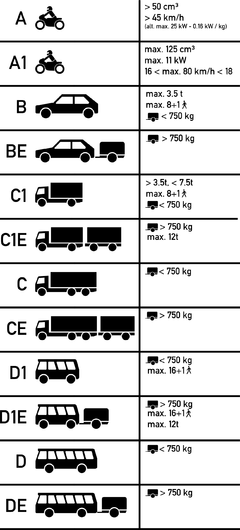
kwilco
Advanced Member-
Posts
5,280 -
Joined
-
Last visited
Content Type
Events
Forums
Downloads
Quizzes
Gallery
Blogs
Everything posted by kwilco
-
Tragic scooter crash in Thailand leaves Queensland dad in coma
kwilco replied to snoop1130's topic in Thailand News
..and does that signify to you? -
The problem is you don't know how to look at an accident...you have no argument just irrelevant comments and repeating them doesn't make them any less irrelevant. Whatever the driver said both your premise and conclusion are just childish, incorrect and irrelevant as I pointed out in my first reply which you don't seem to have either read or understood . You made a silly comment, get over it, learn from your mistake and move on
-
As I said the plural of anecdote is not data and you fail to understand even the basics of stats or how to draw a sensible conclusion from them. The media is hopeless on reporting matters of road safety in THailand they only use one of the mant stats available i.r. deaths per 100k of population. In fact with what you are talking about COLLISIONS per miles/km travelled (billions) is by far a clearer way of looking at it. I have driven further than you in both UK, Europe and Thailand and one thing I observe is that it is much more difficult to observe any accident in UK brcausehthe first res[ponders are so much quicker than in Thailand and the usual practice is to block off the road and take measures against "gawpers". I should make it clear also that it isn't the number of collisions it is the perception and interpretation that is so inaccurate on this thread.
-
You need to look at my post on analysing RTIs. Your comment shows you aren't looking at it holistically. We don't know what caused the accident. However, how serious it was depends on a lot of "techunical" factors....the state of the vehicles, the condition of the road and the safety features included in the design of the road from surface tho roadside objects to lighting etc etc. One of the problems in Thailand is not the collusion but what happens in the seconds minutes and hours after the collision
-
You need to understand the stats. And how to analyse and interpret them. One needs to understand how they are gathered and how they can be used to draw some conclusions but not the amateur rubbish you read here . Depending on which stats you look at it becomes clear that it isn't the number of collisions it is the number of injuries and fatalitiesnper collision where Thailand falls foul. A lot of the anecdotal comments are just confirmation bias from people who simply don't drive enough here or at home to make any realistic comparison. Remember the plural of anecdote is not data
-
Yes a "label". I don't know what this particular bus was...I can't see from the photos. However many buses on Thailand have bodywork build locally on old or secondhand chassis. So the engine and chassis may be Mercedes or any other make but the rest of the vehicle is locally built. To what standards is unclear.
-
what does that even mean?
-
do you remember Taksin bailing someone out a few years back? Maybe that will help?
-
THis is how the ruling elite get rid of people they don't agree with - just keep throwing spurious charges at them which keeps them out of power....no need to assassinate or imprison one of their own
-
You think that in any way is an argument to my post? The fact is your post is an example of how people totally misread an incident even if what the driver said was true...if you READ my post you'd understand why either way your post is not tenable. Just because you don't like it doesn't give you tge right to ask me to stop. This is a discussion about an accident and my point is that many on this thread including yourself seem to have no idea how to assess an RTI even yor conckusion that "If that's true than the bus driver must go to jail for being an idiot driver" This just indicates how little you seem to understand about this topic.
-
What the RTP fail to achieve in the event of an RTI .... Analysing the scene of a collision is a crucial part of any investigation inot a road incident , and it needs to be done in a very systematic way. The initial scene assessment needs to be carried out quickly and thoroughly – in most cases in Thailand it is totally haphazard – this is typically seen as traffic is allowed to pass close or even through the scene. There is a acronym mnemonic for this - “METHANE” : It stands for Make the scene safe, Establish the facts, Treat the injured, Hazards and risks, Access and egress, Notification and Evidence preservation. (this is crucial for finding out what really happened.) Officers are trained to prioritize actions like securing the scene, checking for injuries, and identifying potential hazards. Then the work of sorting out the events can take place. Once the immediate situation is stabilized, a more detailed examination begins. This involves: Physical evidence: E.g. skid marks, debris, vehicle damage, and any other physical traces that can offer clues about the collision's dynamics. Scene measurements are taken and mapped out The scene is meticulously measured and documented Specialized equipment like “total stations” are to create accurate scale diagrams. These are a combination of an electronic distance meter, which uses an infra-red light to measure distance, and a theodolite, or electronic transit. Never seen one used in Thailand. Witness statements: Statements from anyone who witnessed the collision are useful for understanding the sequence of events. They need to be taken very carefully taking into account - Eyewitnesses can be very compelling, but rather than recording experiences flawlessly, memory is susceptible to a plethora of errors and biases. We all make errors in remembering specific details and can even remember whole events that did not actually happen. There is plenty of documented evidence of how most eye witnesses are ultimately unreliable suffering from such things a false biases, false memories and misinformation. (e,g, judging speed) Then vehicles involved are inspected for mechanical issues, damage patterns, and potential digital data like airbag control module readings. Tachographs if fitted In more major or complicated collisions, the digital specialists are called in e.g Forensic Collision Investigators (FCIs): For serious collisions, FCIs have further specialized training and equipment to conduct in-depth scene examinations and reconstructions. They can use techniques like 3D scanning/modelling of the scene for more detailed analysis. They can also extract and interpret data from vehicle electronic control units (e.g. - ECUs). Then there is accident reconstruction software which will recreate or simulate the collision based on gathered evidence to understand its dynamics. After all this has been done the reporting and analysis is carried out. The findings are documented in a comprehensive report that includes: Scene diagrams and photographs. Witness statements and interview summaries. Vehicle examination reports. Any specialist analysis results. Conclusions and recommendations based on the evidence. UK has the one of the lowest road death rates in the world, Thailand one of the highest – a significant fact in this is the lamentable lack of data taken from RTIs. Things you never see in Thailand - scene preservation is paramount yet the Thai police fail to close off accident scenes or even the road. . The scene is secured to prevent contamination or alteration of evidence. Apart from occasional drug/alcohol of drivers testing potential criminal aspects are left unchecked. Most of the investigation is left to under-trained local police not a specific accident investigation unit. I’ve never seen any advanced technology used in role in scene analysis. Tools like drones and 3D scanning enhancing data collection and reconstruction capabilities. What do you get in Thailand? A statement to the press in an impossibly short space of time that sums up the incident in a series of clichés that appear to be designed to make the whole thing go away ASAP. Nothing is learn, roads are left damaged with oil and cargoes seeping into the nearby environment and water table and blame is apportioned regardless of what actually happened. Even worse are the comments by totally uninformed amateurs who every time a crash is reported on EL forums see fit to chime in with the same old rubbish largely based on anecdotal observations, racist and stereotypical generalisations of “all Thais are bad drivers and deserve what they get” –“expats re all superior and superb drivers” Who needs to grow up???
-
Scottish woman’s cliff plunge in Thailand sparks insurance debacle
kwilco replied to webfact's topic in Thailand News
no I'm talking about insurance and definition of a scooter - which you clearly don't know. You actually get halfway there as you now admit it is a "variety" of motorcycle - there is no such thing as a "scooter licence" under the Vienna convention - so how could you be licenced or insured to drive one in THailand. Your insurance looks as if it covers the insured for a peddle scooter! - check out skateboards BTW - the "scooter" shown in the illustration has a hand-operated clutch so by the wiki definition, it isn't a scooter. I've attached the IDP vehicle categories - as you can see there is no such thing as a scooter (or MPV, SUV, sportscar etc etc) -
Scottish woman’s cliff plunge in Thailand sparks insurance debacle
kwilco replied to webfact's topic in Thailand News
You aren't answering / can't answer the question - you simply don't understand the problem and are probably uninsured yourself The OP is about "insurance debacle" - you have failed to define what your insurance company calls a scooter - wiki claims scooters must be fully automatic - the original Vespas were not - whay about the other vehicles which ones does YOUR insurance company allow you to drive? I don't appear to be able to answer - which is the problem th OP had. -
So you've read the a official accident report form? That's curious because the police seldom properly do one and are even less likely to make them publicly available - or were you at the scene and have interviewed al the witnesses and calibrated the scene and done the calculations related to speed and trajectory - did you take into account the overall weight of the bus with the passengers the effects of ABS -the speed of the other vehicles involved the weather conditions, temperature condition of road surface, mechanical condition of both vehicles (was the trailer the correct height?) etc. etc., or are you just believing what you want to?







